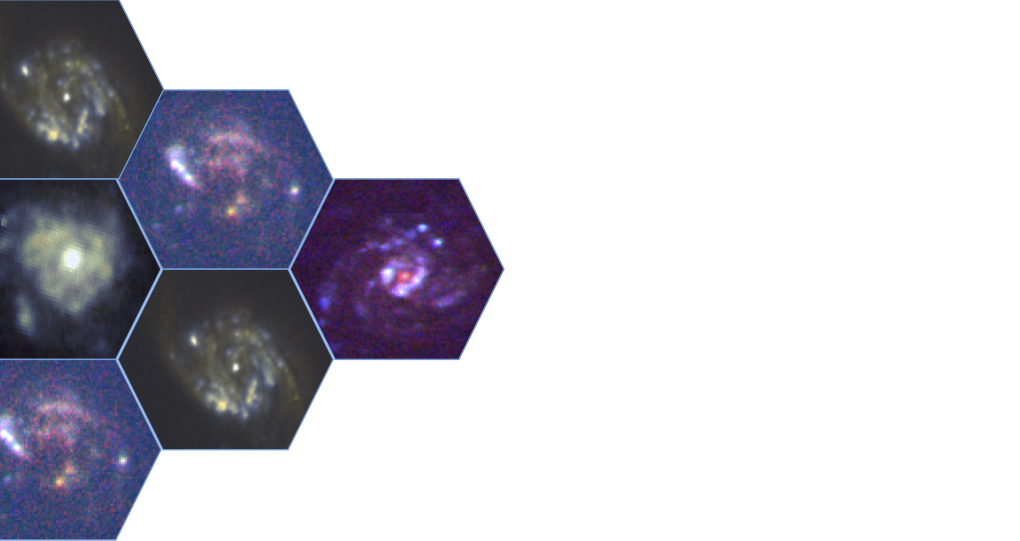
DYNAMO Project
Gas-rich, clumpy, turbulent disk galaxies in your own back yard.
DYNAMO Overview
Motivation: The vast majority of cosmic star formation happens in galaxies of the distant Universe (z=1-3) that existed 10 billion years ago. Because they are so far away, we are limited in the details especially those of resolved properties and faint spectral features in the conditions in which 70-80% of stars in the Universe formed. What we do know about galaxies in the past is that they are completely unlike galaxies like our Milky Way, with far more extreme gas reservoirs, star formation and internal kinematics. This creates a problem. Our theories of galaxy evolution and star formation, which are nominally built on observations of local galaxies, may not apply to the conditions in which most stars form.
The DYNAMO sample is a set of galaxies that have been selected to be similar in many properties to galaxies at z=1-2. We use DYNAMO galaxies as laboratories for the physical mechanims that exist in galaxies of the distant past.
How are DYNAMO galaxies similar to those at z=1-3?
Gas Rich: DYNAMO galaxies have gas fractions of 20-80% (Fisher et al. 2014; White et al 2017; Fisher et al. 2019)
Clumpy: DYNAMO galaxies have clumps of star formation with SFR similar to the clumps seen in high-z surveys like SINS or CANDELS (Fisher et al. 2017; Ali et al. 2017).
Turbulent Kinematics: The velocity dispersion of ionized gas in DYNAMO galaxy is high, like in SINS galaxies, ranging 20-100 km/s (Green et al. 2014; Bassett et al. 2014; Bekiaris et al. 2016). DYNAMO and Keck-AO allows us a unique oppurtunity to map out these high velocity dispersions at high spatial resolution, we find they remain quite high across the disks (Oliva-Altimarano et al. 2018).
Compact, Star bursting disks: We find that DYNAMO galaxies are small (half-light radii of ~1 kpc), but are rotating systems. In Fisher et al. 2017 we show that the SFR surface density and mass surface density of DYNAMO galaxies are basically the same as galaxies at z=1-2.
Low Angular Momentum: Observations and simulation show that the angular momentum of galaxies decreases with redshift. In DYNAMO galaxies we find that despite the absence of a large bulge, they have low angular momentum, similar to galaxies of the ancient Universe. (Obreshkow et al. 2015; Sweet et al. 2020).
DYNAMO has had multiple successul programs with Hubble Space Telescope, Keck/AO, ALMA & NOEMA, and Gemini/GMOS.
If you are intrested in using our data or collaborating with DYNAMO team please contact the team leader, Deanne Fisher.
Clump Clustering: In the right image above we illustrate how clumps are blurred. Typically in the blurred images we find that what appears as a single clump is a cluster of several clumps. Clump clustering implies that it is not simple to interpret the properties of clumps in high-z galaxies.
What is the true size of clumps?
Using Hα images from Hubble Space Telescope we achieve a resolution on DYNAMO galaxies that is 5-10x better than what is typically measured at z=1-2. In Fisher et al 2017a we use these observatoin to simulate to impact of degraded resolution and signal-to-noise on distant galaxies. We measure clump properties at full resolution. Then we blur and degrade the images then remeasure the clump properties. The systematic effect is that clumps are made to appear significantly larger.
The clumps measured in the blurred DYNAMO images are similar in brightness and size to what is seen at high-z. This is shown in the left panel of the figure. Fisher et al. 2017b shows that the sizes of clumps in the full resolution DYNAMO galaxies are exactly what is predicted based on Toomre instability theory. We argue that this is evidence that DYNAMO-HST resolution are tracing the scale of the instability (100-500 pc), and is the proper size for studying clumps in gas-rich, turbulent disks.
DYNAMO Team
Deanne Fisher (PI)
Swinburne Uni.
Karl Glazebrook
Swinburne Uni.
Roberto Abraham
Uni of Toronto
Alberto Bolatto
Uni of Maryland
Marrianne Girard
Swinburne Uni.
Danail Obreschkow
Uni of Western Australia
Clumps are long-lived on the outside and young on the inside
Our team’s recently successful PhD, Dr. Laura Lenkic has lead a paper using HST optical colors to study what happens inside of clumps. This is a one-of-a-kind study that only a program like DYNAMO can do. We find that clumps color gradients indicate that the centers of clumps are young and the outer parts are old. One of the major uncertainties in clumps is if they are long-lived or if they destroy themselves quickly. Laura’s work is consistent with a picture in which clumps are long-lived structures, yet the centers are constantly replenished by accretion of new gas. A concept predicted in simulations by Bournaud et al. 2014.
The diagram on the right illustrates this result. The gas (blue arrows) accretes onto the clumps from the disk and fuels the creation of new stars (blue stars). The massive old stars (yellow) create the gavitational potential that sends the gas to the center. It is due to this that young stars are centrally concentrated. The row of panels at the bottom shows one of the clumps that this picture is motivated by. The age indicating color (u-b) is blue at the center, but there is no such trend in the extenction.
DYNAMO Students
Liyualem Tilahun (Swinburne) : Stellar Masses of Clumps from HST
Laura Lenkic (Maryland) : Internal Structure of Stellar Population of Clumps
Heidi White (Tornonto): Gas fractions and near-IR imaging
Rob Bassett (Swinburne Graduated): Stellar Kinematics and Extinction
Kamran Ali (UWA): Cross-correlation-based Measurement of Clump Sizes
George Bekiaris (Swinburne Graduated): GPU-based Kinematic Modelling
Andy Green (Swinburne Graduated): Original IFU Survey of DYNAMO
Testing Star Formation Theories with DYNAMO Galaxies
Modern star formation theories argue that in galaxies there is a balance of pressures. This is supported by the simple fact that galaxies are not collapsing; they exist in equilibrium. The inward pressure is from gravity. It is the weight of stars, gas and dark matter pushing down. This is balanced by an outward pressure, which many theorists suggest is from “feedback”, which comes from the energy and momentum associated from newly formed stars. A common assumption is that this feedback is dominated by supernova explosions.
DYNAMO galaxies allow us to test these theories in the high star formation regime, which is where most stars in the Universe formed.
In the figure on the left we compare the star formation to the pressure. Feedback based theories predict a linear correlation between these quantities. Yet the data in blue and red dots and squares shows that at high pressure and high star formation rates the theory does not match the data. It is failing at the factor of 50-100x!
The DYNAMO team is now working to follow this up with new, resolved data from ALMA and NOEMA to continue to test a suite of models of star formation in these extreme conditions.









